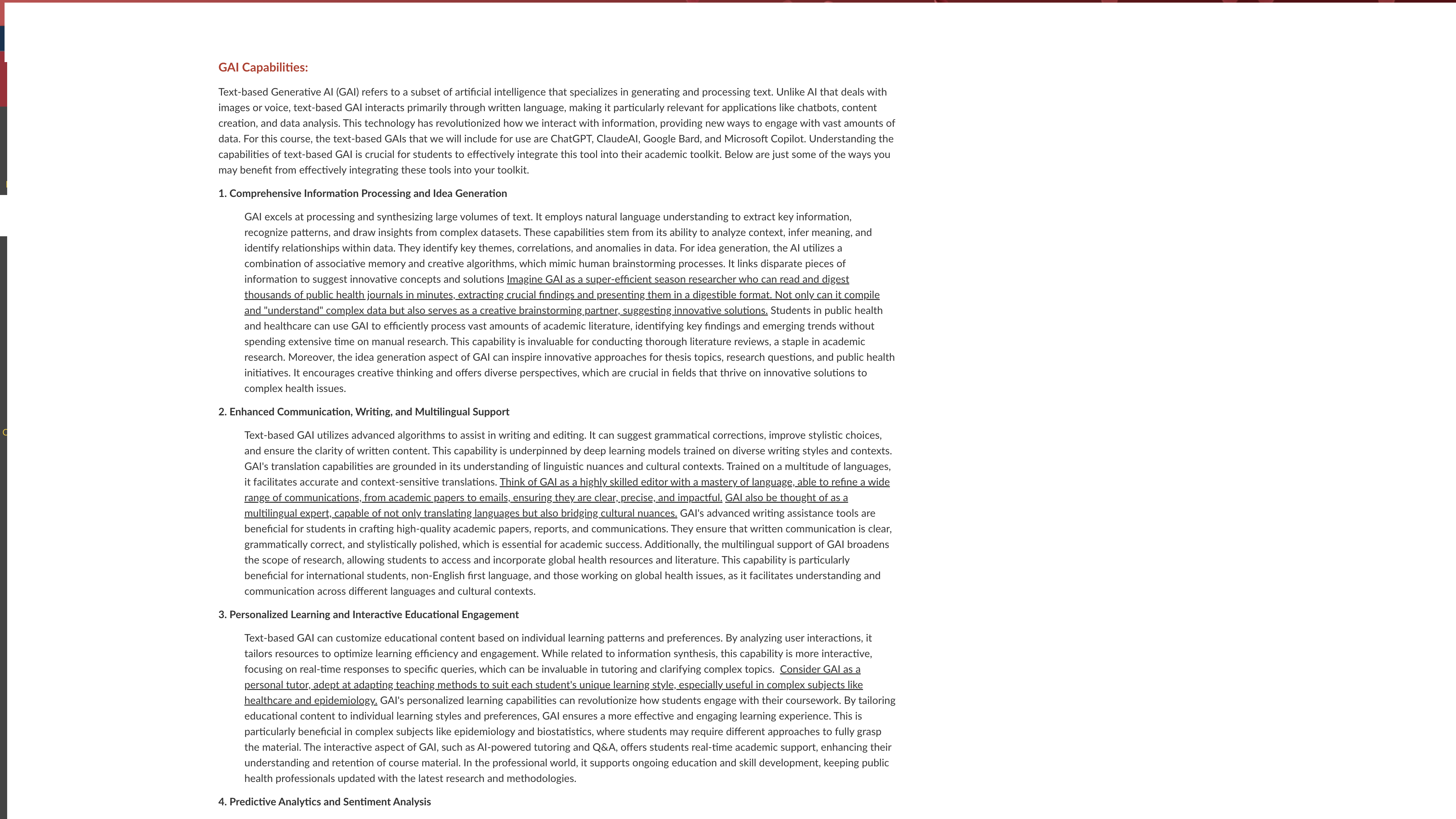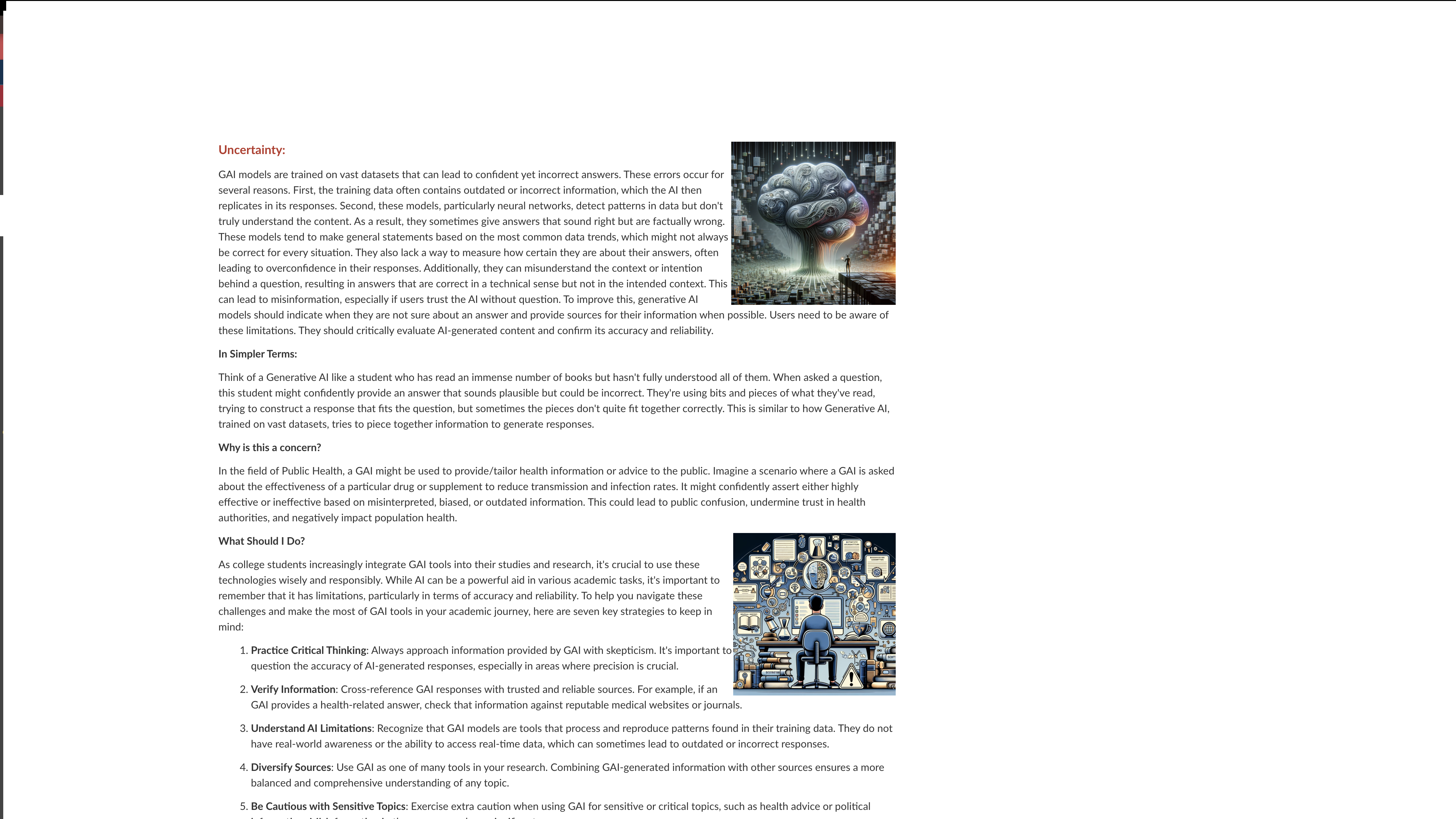Question
explain how the capabilities of text-based Generative AI (GAI) tools cancontribute to increased productivity, success, and quality of work for students.? 2) In what ways
explain how the capabilities of text-based Generative AI (GAI) tools cancontribute to increased productivity, success, and quality of work for students.?
2) In what ways does text-based GAI enhance personalized learning and interactive educational engagement for students?
3) Why is the uncertainty of GAI models a concern in academic settings, and what should students do to mitigate this issue?
4) What are the concerns with biases in Generative AI (GAI) models? Provide an example related to concerns of bias in the context of public health. How can students manage these inherent biases in their academic work?
5) Why is it important to understand the strengths and weaknesses of different Generative AI (GAI) tools like ChatGPT-3.5, Microsoft Copilot, Google Bard, and ClaudeAI?
---------------------------------------------------------------------------------------------------------------------------------------------------------------
Video links and pages are provided.
https://youtu.be/lgDhbh_Qxys
https://youtu.be/hfIUstzHs9A






GAI Capabilities: Text-based Generative AI (GAI) refers to a subset of artificial intelligence that specializes in generating and processing text. Unlike Al that deals with images or voice, text-based GAI interacts primarily through written language, making it particularly relevant for applications like chatbots, content creation, and data analysis. This technology has revolutionized how we interact with information, providing new ways to engage with vast amounts of data. For this course, the text-based GAIs that we will include for use are ChatGPT, ClaudeAl, Google Bard, and Microsoft Copilot. Understanding the capabilities of text-based GAI is crucial for students to effectively integrate this tool into their academic toolkit. Below are just some of the ways you may benefit from effectively integrating these tools into your toolkit. 1. Comprehensive Information Processing and Idea Generation GAI excels at processing and synthesizing large volumes of text. It employs natural language understanding to extract key information, recognize patterns, and draw insights from complex datasets. These capabilities stem from its ability to analyze context, infer meaning, and identify relationships within data. They identify key themes, correlations, and anomalies in data. For idea generation, the Al utilizes a combination of associative memory and creative algorithms, which mimic human brainstorming processes. It links disparate pieces of information to suggest innovative concepts and solutions Imagine GAI as a super-efficient season researcher who can read and digest thousands of public health journals in minutes, extracting crucial findings and presenting them in a digestible format. Not only can it compile and "understand" complex data but also serves as a creative brainstorming_partner, suggesting innovative solutions. Students in public health and healthcare can use GAI to efficiently process vast amounts of academic literature, identifying key findings and emerging trends without spending extensive time on manual research. This capability is invaluable for conducting thorough literature reviews, a staple in academic research. Moreover, the idea generation aspect of GAI can inspire innovative approaches for thesis topics, research questions, and public health initiatives. It encourages creative thinking and offers diverse perspectives, which are crucial in fields that thrive on innovative solutions to complex health issues. 2. Enhanced Communication, Writing, and Multilingual Support Text-based GAI utilizes advanced algorithms to assist in writing and editing. It can suggest grammatical corrections, improve stylistic choices, and ensure the clarity of written content. This capability is underpinned by deep learning models trained on diverse writing styles and contexts. GAI's translation capabilities are grounded in its understanding of linguistic nuances and cultural contexts. Trained on a multitude of languages, it facilitates accurate and context-sensitive translations. Think of GAI as a highly skilled editor with a mastery of language, able to refine a wide range of communications, from academic papers to emails, ensuring they are clear, precise, and impactful. GAl also be thought of as a multilingual expert, capable of not only translating languages but also bridging cultural nuances. GAl's advanced writing assistance tools are beneficial for students in crafting high-quality academic papers, reports, and communications. They ensure that written communication is clear, grammatically correct, and stylistically polished, which is essential for academic success. Additionally, the multilingual support of GAI broadens the scope of research, allowing students to access and incorporate global health resources and literature. This capability is particularly beneficial for international students, non-English first language, and those working on global health issues, as it facilitates understanding and communication across different languages and cultural contexts. 3. Personalized Learning and Interactive Educational Engagement Text-based GAI can customize educational content based on individual learning patterns and preferences. By analyzing user interactions, it tailors resources to optimize learning efficiency and engagement. While related to information synthesis, this capability is more interactive, focusing on real-time responses to specific queries, which can be invaluable in tutoring and clarifying complex topics. Consider GAI as a personal tutor, adept at adapting teaching methods to suit each student's unique learning style, especially useful in complex subjects like healthcare and epidemiology. GAl's personalized learning capabilities can revolutionize how students engage with their coursework. By tailoring educational content to individual learning styles and preferences, GAI ensures a more effective and engaging learning experience. This is particularly beneficial in complex subjects like epidemiology and biostatistics, where students may require different approaches to fully grasp the material. The interactive aspect of GAI, such as Al-powered tutoring and Q&A, offers students real-time academic support, enhancing their understanding and retention of course material. In the professional world, it supports ongoing education and skill development, keeping public health professionals updated with the latest research and methodologies. 4. Predictive Analytics and Sentiment Analysis
Step by Step Solution
There are 3 Steps involved in it
Step: 1

Get Instant Access to Expert-Tailored Solutions
See step-by-step solutions with expert insights and AI powered tools for academic success
Step: 2

Step: 3

Ace Your Homework with AI
Get the answers you need in no time with our AI-driven, step-by-step assistance
Get Started


